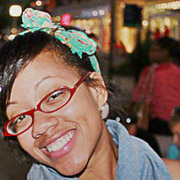After a typhoon, earthquake or uprising, the arts can help
Christina Sturdivant |
Monday, September 14, 2015
Art can not only
heal minds but can heal communities after disaster. Our latest panel discussion showed how improv can help typhoon survivors, painting can help protestors, and photography can help rebuild a landmark.
In honor of National Preparedness Month, the third installment of the DC Commission on the Arts & Humanities' Curate Your Culture series focused on the use of art in times of natural and man-made disasters.
Nearly 50 people gathered for the Arts After Disaster panel at the First Congregational United Church of Christ on September 1st. With no formal introduction, they were instructed to participate in an improvisation game where they spread their arms like wings and curled them like claws in a series of motions to become eagles and bears.
As they took animalistic form, they went from curious and ecstatic to angry and aggressive as directed by panelist Mary Tyszkiewicz, founder of Herioc Improv.
“One of the things about disasters is you are put into a time and place that you weren’t expecting,” said Tyszkiewicz after stopping the game. “Sometimes that can feel very freeing because things are literally falling apart, but you can also feel very stupid and very confused.”
Tyszkiewicz then introduced herself as the founder of an organization that teaches theatrical improvisation techniques to prepare people for high-stakes situations.
Rounding out the panel were James W. Shepherd, Director of Facilities and Preservation at the Washington National Cathedral and Kalima Young, Founder of the Baltimore Art + Justice Project in Baltimore, Md.
The purpose of the conversation was to discuss the power of art in its varying forms by hearing stories from each panelist, said moderator Joseph C. Dunn of Huntington T. Block Insurance.
Preparing for Disaster
When asked about her most thrilling experience as an improv teacher, Tyszkiewicz spoke of her time in the Philippines just four months after Super-Typhoon Haiyan hit the country in 2013.
She taught classes in 12 communities over 15 days. Individuals who participated in workshops were part of communities that had been devastated. They loss homes and loved ones to disaster. “One woman said ‘I don’t want to go through another one--I’d rather die,’” recalled Tyszkiewicz.
However, after participating in her courses, participants gained confidence, she said. They were able to work in small groups and use their innate abilities to prepare themselves for another disaster.
In speaking of her work, Young shared that those most impacted are victims of manmade disasters. In 2013, she created the Baltimore Art + Justice Project as a way for local artists to connect with nonprofits and activists. “When there’s an activist movement taking place, people see artists as tack on folks--they engage them for campaign materials instead of [inviting] them to be at the table,” said Young, who views artists as a much more powerful force in times of crisis.
In April 2015, 25-year-old African-American Freddie Gray died after injuries suffered while in police custody. Soon after, residents of Baltimore flooded the streets in protest.
“I was happy that my project existed because it fulfilled a very immediate need,” said Young. “People wanted to know where they could go to do artistic intervention in the middle of the protests.”
The platform allows groups or individuals to log their location through an interactive map. This has allowed activists and artists in similar neighborhoods to connect on projects. It’s also allowed communities devoid of art and social justice activity to gain resources.
With the National Guard behind them and protesters in front of them, said Young, artists began to paint their surroundings. They were also encouraged to share and upload photos to create an art archive memorializing the pain and beauty of the time.
Aftermath and Moving Forward
When asked to discuss the National Cathedral, which suffered $34 million in damages following the 2011 earthquake, Shepherd discussed art as a catalyst for emotional and physical restoration.
Colin Winterbottom was the only photographer permitted to take photos during the reconstruction process. “He was able to get up close to the art and craft of the building to celebrate things that we haven’t been able to touch since they’ve been put in,” said Shepherd.
For individuals who love the building, it also gave them a sense of healing and reassurance that work was being done. This is also important, continued Shepherd, because “public memory disappears and interest wanes.” The ability for photos to keep the damages at the forefront of people’s minds will hopefully assist in raising the $24 million still needed to finish the restoration.
When asked about financial support for her project, Young’s response was similar, in that it is lacking.
“Making the case—especially in Baltimore—for how you can use art as interventional practice as opposed to art as creative placemaking is a tricky conversation,” she said. “No one just wants to give money to artists and activists to just do stuff.”

Christina Sturdivant is a native Washingtonian who's always watching and writing about the latest cultural, community and innovative trends in the city. She's interested in people and companies that create equitable opportunities for longtime residents and transplants alike.